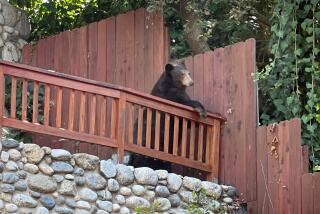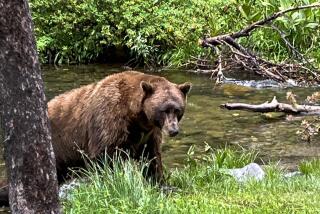Grim outlook for grizzlies in Yellowstone region
Reporting from Cody, Wyo. — It’s been a bad year for grizzly bears, and, if forecasts prove correct, it’s only going to get worse.
The tally of grizzly deaths in the states bordering the greater Yellowstone region is fast approaching the worst on record. And that’s before the numbers come in from the current hunting season, a time when accidental grizzly shootings are traditionally high. Here in Wyoming, more bears were killed this year than ever, including a bear shot by a hunter last week.
A number of complex factors are believed to be working against grizzlies, including climate change. Milder winters have allowed bark beetles to decimate the white-bark pine, whose nuts are a critical food source for grizzlies. Meanwhile, there has been a slight seasonal shift for plants that grizzlies rely on when they prepare to hibernate and when they emerge in the spring, changing the creatures’ denning habits.
The result, some biologists say, is that bears accustomed to feasting on berries and nuts in remote alpine areas are being pushed into a more meat-dependent diet that puts them on a collision course with the other dominant regional omnivore: humans.
“A grizzly is a top-level carnivore; at times he will act like one,” said Chuck Neal, author of “Grizzlies in the Mist,” who lost a botanist friend to a grizzly attack this year. “People are a readily available source of high-quality protein. We eat too much and exercise too little. We’re like a hot dog on two legs.”
Chris Servheen, a grizzly researcher for the U.S Fish and Wildlife Service, downplays the role of white-bark pine loss, noting that grizzlies are highly adaptive and don’t specialize on white-bark pine.
“It’s easier to describe what they don’t eat than what they do,” Servheen said.
Still, the evidence is not encouraging for the grizzly, which was placed on the endangered species list in 1975.
Two years ago, 52 grizzlies died from human causes in the Yellowstone area. As of the end of October, 48 bears have been killed this year.
The phenomenon is repeated with other bear species across the region. From New Mexico to the Canadian border, wildlife agencies are reporting hungry black and brown bears roaming into backyards to get at dog food, ransacking campgrounds, and challenging elk and deer hunters for their kills.
There is another chilling footnote to 2010: For the first time anyone can remember, grizzlies attacked and killed two people. In June, Neal’s friend the botanist was alone when he stumbled upon a “nuisance” bear west of Cody, Wyo., just as it was coming out of anesthesia after being relocated by wildlife officials. In July, near Cooke City, Mont., an undernourished sow with three cubs stalked a group of sleeping campers over several hours, attacking two people before killing one man. Parts of the victim were found in the sow’s stomach.
Maulings of humans are up around the Rockies — occurring at twice the yearly average in Wyoming — and grizzlies in record numbers are being euthanized by wildlife managers because of persistent run-ins with people, including hunting livestock.
“In 2008 we had a huge pile-up of dead bears; this year could get to that,” said Louisa Willcox, who studies bears for the Natural Resources Defense Council. “These conflicts should be seen as warning signs, flashing yellow lights.”
As they continue to interact with humans and harass and kill livestock, bears risk earning the type of scorn heaped on wolves in the region, which are viewed less as an emblematic creature of the West and more as varmints that plague the landscape.
“Public tolerance is starting to wane somewhat,” said Mark Bruscino, bear management supervisor for Wyoming’s Department of Game and Fish. “You can look at the mountains and know there are grizzly bears there — that sits pretty good with people. But when you go to your kid’s 4-H facility and bears have ruined the place, that changes things. People in Wyoming think they have enough bears.”
If a shift in public perception drives changes in policy, grizzly bears could be legally hunted in the Lower 48 for the first time in nearly four decades.
To Bruscino, it’s simply wise game management to “harvest” animals, and might be better for bears. “Right now there’s no value on bears,” he said. “If people are allowed to compete for a limited number of hunting licenses, people will start to [ascribe] more value to bears.”
The animals may be a victim of the success of conservation efforts. In 2007, the species was considered to have recovered enough to be taken off the endangered species list. But a court overturned that decision last year and returned the bears to “threatened” status, a decision U.S. Fish and Wildlife is appealing.
Wildlife officials meeting last week in Montana concluded the region’s grizzly population is about 600, nearly three times the 1975 numbers. Some concluded that the increased bear conflicts signal that the region has reached its carrying capacity for grizzlies.
“The bucket is getting full,” said Chuck Schwartz, who heads the federal Interagency Grizzly Bear Study Team. “You have to think about how many bears we should have in this ecosystem. The greatest single predictor for conflict is the number of bears.”
With more bears and more people stuffed into the 22,000 square miles of bear habitat, something has to give, and no one here has a simple answer.
Grizzlies “don’t realize that setting up in a subdivision is a bad thing,” Schwartz said. “They perceive it as suitable habitat — food, space and no competition. What they don’t realize is there’s a lot of people. You can expect to have conflict and bear mortalities — it’s a given when bears and people live in the same area.”
“In order to adapt to other food sources, they must be able to range far afield,” author Neal said. “It will continue to be this way until we allow the bears to expand their range. Right now, we’re maintaining an open zoo.”
The two bear attacks that resulted in human fatalities shocked experts, who were at a loss, especially, to explain the predatory behavior of the sow and her three cubs. But an investigative report that included a necropsy of the female bear may have provided the answer: the bears were simply hungry.
In spare, clinical terms the report describes the mother bear as thin and undernourished. Her three offspring were likewise skinny. “Nutritionally stressed” is the term used. The female’s stomach contents show she had not eaten pine nuts, nor much of anything else, before the attack. Her intestines were ravaged by parasites. She may not have been able to provide enough milk for her cubs.
After the attack, authorities captured the four bears near the site, surmising that the family was resting before returning to its kill. The mother was euthanized and the three cubs were taken to a zoo in Bozeman — where they were fed meat and fruit, which they readily ate.
More to Read
Sign up for Essential California
The most important California stories and recommendations in your inbox every morning.
You may occasionally receive promotional content from the Los Angeles Times.










